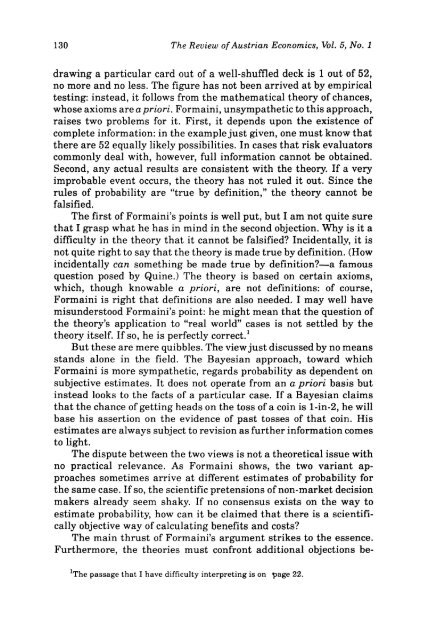Review of Austrian Economics - The Ludwig von Mises Institute
Review of Austrian Economics - The Ludwig von Mises Institute
Review of Austrian Economics - The Ludwig von Mises Institute
Create successful ePaper yourself
Turn your PDF publications into a flip-book with our unique Google optimized e-Paper software.
130 <strong>The</strong> <strong>Review</strong> <strong>of</strong> <strong>Austrian</strong> <strong>Economics</strong>, Vol. 5, No. 1<br />
drawing a particular card out <strong>of</strong> a well-shuffled deck is 1 out <strong>of</strong> 52,<br />
no more and no less. <strong>The</strong> figure has not been arrived at by empirical<br />
testing: instead, it follows from the mathematical theory <strong>of</strong> chances,<br />
whose axioms are a priori. Formaini, unsympathetic to this approach,<br />
raises two problems for it. First, it depends upon the existence <strong>of</strong><br />
complete information: in the example just given, one must know that<br />
there are 52 equally likely possibilities. In cases that risk evaluators<br />
commonly deal with, however, full information cannot be obtained.<br />
Second, any actual results are consistent with the theory. If a very<br />
improbable event occurs, the theory has not ruled it out. Since the<br />
rules <strong>of</strong> probability are "true by definition," the theory cannot be<br />
falsified.<br />
<strong>The</strong> first <strong>of</strong> Formaini's points is well put, but I am not quite sure<br />
that I grasp what he has in mind in the second objection. Why is it a<br />
difficulty in the theory that it cannot be falsified? Incidentally, it is<br />
not quite right to say that the theory is made true by definition. (How<br />
incidentally can something be made true by definition?—a famous<br />
question posed by Quine.) <strong>The</strong> theory is based on certain axioms,<br />
which, though knowable a priori, are not definitions: <strong>of</strong> course,<br />
Formaini is right that definitions are also needed. I may well have<br />
misunderstood Formaini's point: he might mean that the question <strong>of</strong><br />
the theory's application to "real world" cases is not settled by the<br />
theory itself. If so, he is perfectly correct. 1<br />
But these are mere quibbles. <strong>The</strong> view just discussed by no means<br />
stands alone in the field. <strong>The</strong> Bayesian approach, toward which<br />
Formaini is more sympathetic, regards probability as dependent on<br />
subjective estimates. It does not operate from an a priori basis but<br />
instead looks to the facts <strong>of</strong> a particular case. If a Bayesian claims<br />
that the chance <strong>of</strong> getting heads on the toss <strong>of</strong> a coin is l-in-2, he will<br />
base his assertion on the evidence <strong>of</strong> past tosses <strong>of</strong> that coin. His<br />
estimates are always subject to revision as further information comes<br />
to light.<br />
<strong>The</strong> dispute between the two views is not a theoretical issue with<br />
no practical relevance. As Formaini shows, the two variant approaches<br />
sometimes arrive at different estimates <strong>of</strong> probability for<br />
the same case. If so, the scientific pretensions <strong>of</strong> non-market decision<br />
makers already seem shaky. If no consensus exists on the way to<br />
estimate probability, how can it be claimed that there is a scientifically<br />
objective way <strong>of</strong> calculating benefits and costs?<br />
<strong>The</strong> main thrust <strong>of</strong> Formaini's argument strikes to the essence.<br />
Furthermore, the theories must confront additional objections belr<br />
<strong>The</strong> passage that I have difficulty interpreting is on $>age 22.

















